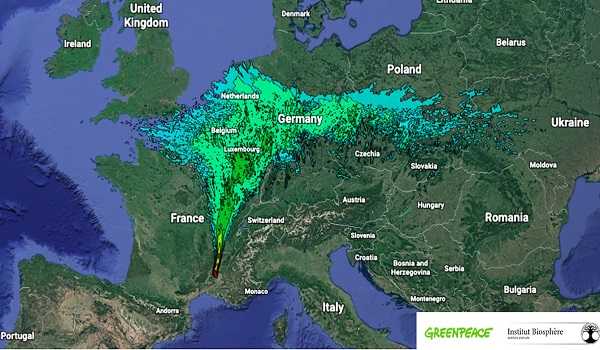 Credit: Institut Biosphère / Greenpeace France
Credit: Institut Biosphère / Greenpeace France
A project carried out by the Institut Biosphère in partnership with Greenpeace France has indicated that Luxembourg would not be "immune" in the case of a nuclear accident at the Tricastin power plant in southeastern France.
The Institut Biosphère and Greenpeace France recently produced radiation dispersion maps, which reveal that nearby French cities but also Luxembourg, as well as Munich, Innsbruck, Brussels, London, Milan and Barcelona, could be impacted by a major nuclear accident at the Tricastin nuclear power plant in Drôme, depending on climatic conditions.
The modelling of more than 1,000 maps, each corresponding to a meteorological situation that occurred during the years 2017, 2018 and 2020, makes it possible to assess the direction and level of danger of the radioactive cloud generated if a Fukushima-type accident were to occur at the Tricastin power plant.
On average, out of all 1,096 meteorological configurations studied, more than thirteen million people would receive a radiation dose in a few hours that exceeds the public exposure limit, set at 1 mSV per year. Depending on weather variations, almost all regions and large cities in France could be contaminated as well as neighbouring countries.
"The Tricastin nuclear power plant, [which is] ageing and exposed to seismic risk but which EDF [Électricité de France S.A.] wants to operate for at least ten years, is a threat to millions of people, first in Auvergne-Rhône-Alpes but also on a national and European scale”, estimated Roger Spautz, nuclear campaign manager at Greenpeace France and Luxembourg.
Greenpeace has warned on several occasions of the risks posed by this power plant. According to the environmental non-profit, the vessel of one of the reactors has more than 20 cracks. The power plant is also located six metres below the level of the Donzère-Mondragon canal; in the event of an earthquake, a rupture of the weakened dike cannot be ruled out. A resulting flood could lead to a nuclear fuel meltdown accident for the four reactors at the Tricastin power plant, according to Greenpeace.
In addition, the power plant is located in an area with a high seismic risk, as highlighted by the Teil earthquake of 11 November 2019. The French Institut de radioprotection et de sûreté nucléaire (IRSN) recently published a new opinion on the seismic movements to be taken into account for the safety of the nuclear installations of Cruas and Tricastin following this earthquake and concluded that "in the state of knowledge, the arguments provided by EDF do not allow to rule out an impact of the experience feedback from the Teil earthquake on the definition of the hazard of the Tricastin site. IRSN considers that it is necessary to consolidate knowledge of the seismic hazard in the region of the Tricastin site”. Greenpeace maintained that almost 20 months after the Teil earthquake, it is still unknown whether the Tricastin nuclear power plant is designed to withstand a high intensity earthquake.
Roger Spautz concluded: “The French government must show responsibility by taking action now on the closing date for the Tricastin power plant. This is the only way to protect the populations, while allowing the reconversion of the territory".








